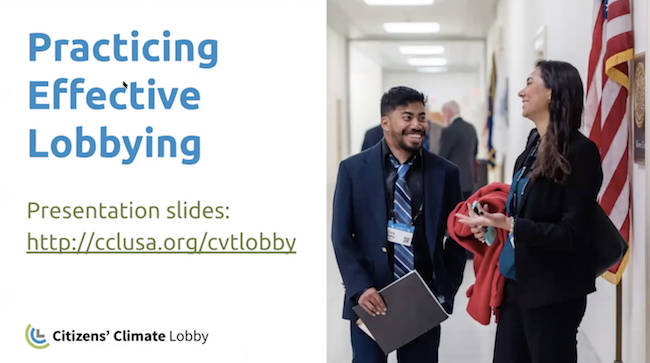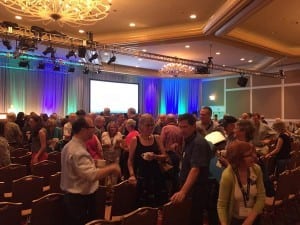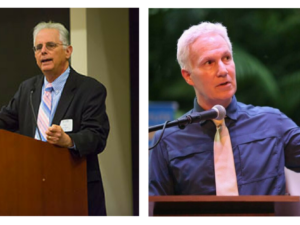Practice effective climate lobbying with a meeting demonstration
By Claire Squire
Citizen lobbying is an empowering experience, and hundreds of CCL volunteers will have that experience at our upcoming November Lobby Day. In this Citizens’ Climate University recap, host Brett Cease and Amy Bennett, CCL’s Director of Congressional Liaisons and Lobby Days, explain the structure of a CCL lobby meeting, demonstrating the step-by-step process with mock lobbying conversations and providing strategies for success.
Check out the full training below, or keep reading for a written recap and short video clips:
Setting the tone
At the beginning of your lobby meeting, your group has the opportunity to set a positive tone for the rest of the discussion. CCL recommends that groups begin by thanking the member of Congress (MOC) or aide they are meeting with for taking the time to have a conversation. Next, the time-keeper should confirm how long the MOC or aide can spend in a meeting, reinforcing that CCL is considerate of people’s time. After confirming the duration of your lobby meeting, the Appreciator (or whomever in your group is fulfilling that role) thanks the MOC or aide for something the member has done. Volunteers are free to be creative when coming up with things to thank their MOC for; it does not have to be climate related.
Examples of ways to appreciate your MOC:
- The Appreciator could thank a MOC for signing onto a bipartisan bill that funds an issue important to them.
- A member of the lobby group who is a veteran might thank a MOC for supporting a bill that assists veterans in their district.
- The Appreciator could thank a MOC for speaking at their child’s school or another community event.
- The Appreciator could thank a MOC for their military service.
After appreciating your MOC, the Asker should begin preparing to make the ask. Throughout the beginning of your lobby session, do not go off topic if other political issues are brought up. Talking about climate change and the potential of the Energy Innovation Act should be the clear focus of your conversation. As Brett reminds us, the “worst outcome is you leave and they have no idea why they are there.” In the video below, Brett and Amy act out the beginning of a lobby meeting. Brett plays the role of a congressman from West Virginia, and Amy plays the role of a citizen lobbyist.
The meat of the discussion
After introductions, volunteers and the MOC discuss the bill at hand. It is important to spend the beginning of your meeting gauging the congressperson’s concerns and values, but if the first few minutes of conversation are not particularly illuminating, lobbyists can rely on what they have gleaned from reading lobby sheets and researching the MOC. When explaining the policy or describing the impact it will have on their district, frame your discussion around the MOC’s values. Throughout your conversation, ask questions to make sure you understand what the MOC means when they make statements, and feel free to ask the MOC to clarify their thoughts. Try to address specific concerns the MOC has about the policy, making note of any bridges you may discover that could bring them onboard in the future. Throughout the meeting, try to find common ground and look for ways that CCL can continue to build a relationship with the MOC. In the video below, watch Brett and Amy act out using good communication skills in a lobby meeting.
Wrapping up your meeting
As your conversation continues, the Timekeeper should remain aware of how much time is left. Additionally, by paying attention to body language, lobbyists can be cognizant of when their session is coming to a close. Typically, if a MOC or their aide closes their notebook, it is time for the meeting to wrap up. Before ending your conversation, be sure to ask if the MOC is interested in more information about the bill, or if a study might help them understand a particular implication of the bill. Additionally, group members should consider asking the MOC if there is someone in their district whose opinion on climate or energy policy matters to them. This step could help volunteers discern who is influential and where to focus their grasstops outreach. When it is time for the meeting to end, be sure to thank the MOC or aide again for taking the time to meet with your group.
Final steps
When the meeting ends, your lobby group should step out into the hallway and find a spot away from the office for a quick debrief. First, discuss your takeaways from the meeting, making sure that the note taker has compiled a comprehensive overview of the discussion for submission to CCL. Next, confirm who is going to follow up with the office, ensuring that the office hears from them again in the next one to two days. Finally, all members of the lobby group should sign a thank-you card and give it to someone in the MOC’s office. With one final appreciation directed toward whomever the lobby group met with, your lobby meeting is complete.
We can’t wait to see all of our volunteers putting these skills into action at our November Lobby Day next month! If you can join us in D.C. on Nov. 11-12, register now for the event. If you have questions about lobbying, head to the Lobbying Congress forum on CCL Community.
Claire Squire is an intern with CCL’s Communications team and a second-year Environmental Management student at Indiana University.






